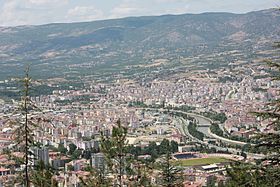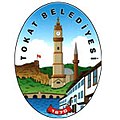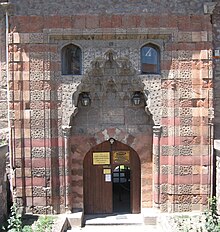Tokat
| Tokat | ||||
|
||||

|
||||
| Basic data | ||||
|---|---|---|---|---|
| Province (il) : | Tokat | |||
| Coordinates : | 40 ° 19 ' N , 36 ° 33' E | |||
| Height : | 623 m | |||
| Residents : | 153,840 (2019) | |||
| Telephone code : | (+90) 356 | |||
| Postal code : | 60,000 | |||
| License plate : | 60 | |||
| Structure and administration (as of 2019) | ||||
| Structure : | 42 Mahalle | |||
| Mayor : | Eyüp Eroğlu ( AKP ) | |||
| Postal address : | Alipaşa Mahallesi GOP. Bulvarı No: 184 60100 Tokat |
|||
| Website: | ||||
| Tokat County | ||||
| Residents : | 199,805 (2019) | |||
| Surface: | 2,003 km² | |||
| Population density : | 100 inhabitants per km² | |||
Tokat ( Armenian Եւդոկիա Ewdokia ; Greek Τοκάτη, Τοκάτιον) is the capital of the Turkish province of Tokat and at the same time the center of a district directly subordinate to the governor (Vali), the central district ( Merkez ). The city lies between Sivas and Niksar in the Yeşilırmak valley . It is about 320 kilometers to the west to the state capital Ankara.
geography
district
The central district (Merkez) Tokat is centrally located in the province. In the West, the circles limits (with the southernmost starting) Yeşilyurt , Artova , Pazar and Turhal , bordered to the north of the county Erbaa , in the northeast of the county Niksar , in the southeastern borders of the district Almus and finally in the south of the county Yildizeli (province of Sivas ).
In terms of area and population, the district is the largest district in the province and has the highest population density with 100.5 inhabitants per km² (for comparison, the province has 61.0 inhabitants per km²). In addition to the provincial capital (around a quarter of the provincial population at the end of 2018), the district consists of four other municipalities ( Belediye ):
- Çamlıbel (4,093)
- Çat (3,935)
- Güryıldız (2,104)
- Emirseyite (2,054 pop.)
In addition, 107 villages with an average of 323 residents belong to the district. The largest villages are:
- Taşlıçiftlik (1,648)
- Semerci (1,554)
- Büyükyıldız (1,168)
- Ormanbeyli (1,082)
- Küçükbağlar (1,030)
- Kemalpaşa (1,016)
- Gozova (977)
- Çerçi (776)
- Yağmurlu (731 pop.)
43 of the villages have 323 or more inhabitants (= average).
The urban population in the central district is 82.80 percent.
Climate table
| Tokat (611 m) | ||||||||||||||||||||||||||||||||||||||||||||||||
|---|---|---|---|---|---|---|---|---|---|---|---|---|---|---|---|---|---|---|---|---|---|---|---|---|---|---|---|---|---|---|---|---|---|---|---|---|---|---|---|---|---|---|---|---|---|---|---|---|
| Climate diagram | ||||||||||||||||||||||||||||||||||||||||||||||||
| ||||||||||||||||||||||||||||||||||||||||||||||||
|
Monthly Average Temperatures and Rainfall for Tokat (611 m)
|
||||||||||||||||||||||||||||||||||||||||||||||||||||||||||||||||||||||||||||||||||||||||||||||||||||||||||||||||||||||||||||||||||||||||||||||||||||||
population
Population development
The following table shows the comparative population level at the end of the year for the province, the central district and the city of Tokat as well as the respective share at the higher administrative level. The figures are based on the address-based population register (ADNKS) introduced in 2007.
| year | province | district | city | ||
|---|---|---|---|---|---|
| absolutely | proportionally (%) | absolutely | proportionally (%) | absolutely | |
| 2018 | 612,646 | 32.86 | 201.294 | 76.75 | 154,495 |
| 2017 | 602.086 | 32.62 | 196.386 | 77.56 | 152.314 |
| 2016 | 602,662 | 31.87 | 192.065 | 77.13 | 148.149 |
| 2015 | 593,990 | 31.77 | 188,736 | 75.62 | 142,724 |
| 2014 | 597.920 | 31.05 | 185,626 | 74.25 | 137.831 |
| 2013 | 598,708 | 30.79 | 184,345 | 72.57 | 133,777 |
| 2012 | 613.990 | 29.68 | 182.225 | 72.68 | 132,437 |
| 2011 | 608.299 | 29.98 | 182.371 | 72.54 | 132,300 |
| 2010 | 617.802 | 30.46 | 188.173 | 72.59 | 136,595 |
| 2009 | 624,439 | 29.24 | 182,572 | 71.14 | 129,879 |
| 2008 | 617.158 | 28.61 | 176,564 | 70.51 | 124,496 |
| 2007 | 620.722 | 29.20 | 181.262 | 70.61 | 127.988 |
Census results
The following population information about the city, the district, the province and the country is available for the censuses:
| region | 1965 | 1970 | 1975 | 1980 | 1985 | 1990 | 2000 |
|---|---|---|---|---|---|---|---|
| City (Şehir) | 37,368 | 44.110 | 48,588 | 60,855 | 73.008 | 83.058 | 113,100 |
| central circle (Merkez) | 94.132 | 103,681 | 112,476 | 127,541 | 142.027 | 150771 | 174,700 |
| Province (İl) | 495.352 | 540,855 | 599.166 | 624.508 | 679.071 | 719.251 | 828.027 |
| Turkey | 31,391,421 | 35.605.176 | 40,347,719 | 44,736,957 | 50,664,458 | 56.473.035 | 67,803,927 |
history
Tokat, the ancient Eudoxia (also called Eudocia or Eudokia ) is an Anatolian city with a long history, starting with the Hittites in the 2nd millennium BC. However, it did not play a major role in antiquity , only its fortress Dazimon was important . The neighboring Comana Pontica was much more important . From there, today's city was founded under Emperor Herakleios (610-641) and named after his daughter Eudokia. Around 1021 Senekerim received Arzruni from Sebaste Tokat as a fiefdom of the Byzantine emperor. The Armenian Arzrunids had resettled westward before the Seljuks . In 1045 Tokat passed to the Armenian Bagratid dynasty by marriage . The Turkmen Danishmends ruled from 1071 to 1175 . Trading flourished in Tokat from the 11th to the 13th centuries. In 1396 the Turkmen emirate of Tokat became Ottoman . In the 17th century Evliya Çelebi compared the prosperity of Tokat with Bursa and Aleppo . In the 19th century, Tokat was one of the largest cities in Asian Turkey.
The population of Tokat comprised a high proportion of Christians until the 20th century. The Armenian Apostolic Church made up the majority with seven congregations, five schools and its own archbishop. He usually resided in the Armenian St. Joachim-and-Anna monastery outside the city and was often also its abbot. The Anglican priest and Bible translator Henry Martyn, who died in Tokat in 1812, was buried in the Armenian cemetery . The everyday Turkophone Greek Orthodox community owned a church and several schools; the Greek archbishop residing in Tokat carried the title of the ancient bishopric Neocaesarea (now Niksar ). In the 19th century, Tokat became a center of Catholicism in the Pontus area . In 1859 the diocese of Tokat degli Armeni of the Armenian Catholic Church was founded, but in 1892 it was merged with Sebaste ( Sivas ) and since then has only been granted as a titular diocese (1972) . The Jesuits who worked here from 1881 (nominally until 1926) maintained a college and the Congregation of the Armenian Sisters of the Immaculate Conception of Mary maintained a monastery. The Jesuit Guillaume de Jerphanion , the first explorer of cave architecture in Cappadocia, worked in Tokat from 1903 to 1907 and 1926 . Around 1854 there was a larger Armenian Protestant community. American Protestant missions emerged from 1864.
Tokat's gradual political and economic decline began with the rise of the neighboring city of Sivas . On May 1, 1914, Tokat's main shopping street was burned down. On May 9, 1915, the Armenians were deported from the city in the course of the genocide . The future Armenian diaspora bishop Krikor Balakian was an eyewitness . In the course of the Greek-Turkish population exchange in the 1920s , the inhabitants of Tokat's Greek Orthodox denomination had to leave their homeland, although they used Turkish everyday and private prayer language. Until the 20th century, many residents emigrated to America or Europe.
Attractions
- Tokat Castle: originally a Byzantine castle, renovated by the Ottomans.
- Historic old town with numerous buildings from the Ottoman period.
- Gök Medrese: Seljuk building from 1275; the Archaeological and Ethnographic Museum is located here.
- Ulu Mosque, renewed in 1679.
- Taş Han: Ottoman caravanserai from 1631.
- Hıdırlık Bridge: Seljuk Bridge.
- Ballıca Cave.
- Sebastopolis : ancient city near Artova.
- Comana Pontica : ancient city near Gümenek.
- Niksar (ancient Neocaesarea), early Christian episcopal city, former capital of the Danischmenden .
In the vicinity of Tokat there are a number of prehistoric settlement mounds (in Turkish : höyük ):
- Maşat Höyük near Yalınyazı.
- Horoztepe.
- Boyunpınar.
- Bolus Aktepe.
kitchen
- Tokat Kebabı
- Keşkek (wheat grains cooked with butter, poured over with cooked lamb and the broth)
- Tokat Bati
- Tokat Yaprağı
- Tokat Çemeni
Daughters and sons of the city
- Michael von Tokat (around 1595 – around 1660), Armenian copyist and miniaturist ( floruit 1606–1658)
- Vartan Hunanian (1644–1715), Armenian Catholic Bishop of Lviv
- Avetik von Tokat (1657–1711), Patriarch of the Armenian Patriarchate of Constantinople
- Ömer Fevzi Paşa (1818–1878), Ottoman general
- Osman Nuri Pasha (1832–1900), Ottoman general
- Josef von Haas (1847–1896), Consul General of the Austro-Hungarian Monarchy in Shanghai
- Ali Talat Bey (1869–1922), Ottoman architect
- Krikor Balakian (1875–1934), Armenian bishop
- Nurhan Atasoy (* 1934), historian of cultural history
- Erhan Afyoncu (* 1967), historian
- Ekin Deligöz (* 1971), politician (Alliance 90 / The Greens)
- Behram Zülaloğlu (* 1982), football player
- Emre Batur (* 1988), national team volleyball player
- Ömer Arslan (* 1993), football player
Web links
- Tokat Museum ( Memento from November 27, 2005 in the Internet Archive )
Individual evidence
- ↑ a b Türkiye Nüfusu İl ilçe Mahalle Köy Nüfusları , accessed on April 10, 2020
- ↑ Central Dissemination System / Merkezi Dağıtım Sistemi (MEDAS) of the TÜIK , accessed on July 27, 2019
- ↑ Genel Nüfus Sayımları - İllere göre ilçe, bucak, belde ve köy nufusları (census results 1965 to 2000) , accessed on July 27, 2019
- ↑ from Greek : Εὐδοκία Eudo'cia , Dictionary of Greek and Roman Geography (1854)
- ↑ Arshag Alboyadjian: History of the Armenians of Evdokia. Neuer Stern Verlag, Cairo 1952, p. 187 (original title: Պատմութիւն Եւդոկիոյ Հայոց. Տեղագրական Պատմական Եւ Ազգագրական Տեղեկութիւններով :)
- ^ A b Robert H. Hewsen: Armenia. A Historical Atlas. University of Chicago Press, Chicago 2001, p. 191.
- ^ Ferdinand Brockes: Across Asia Minor. Pictures from a winter trip through the Armenian emergency area . Bertelsmann, Gütersloh 1900, 152: “The population is calculated at 35,000, including about a third Armenians and several thousand Greeks; There is also a Protestant community and a Roman Catholic with a Jesuit school ”.
- ^ Journey of the missionary Joseph Wolff through Asia Minor, Turkestan, Bokhara, Afghanistan, Cabul and Caschmire to northern and southern India in the years 1831–1834. In: Magazine for the Latest History of the Evangelical Missionary and Bible Societies 1837, p. 590.
- ↑ https://www.collectif2015.org/fr/Le-monastere-de-Saint-Joachim-Sainte-Anne.aspx >
- ^ Journey of the missionary Joseph Wolff through Asia Minor, Turkestan, Bokhara, Afghanistan, Cabul and Caschmire to northern and southern India in the years 1831–1834. In: Magazine for the Latest History of the Evangelical Missionary and Bible Societies 1837, p. 589.
- ↑ Pierre Pierre: Les villes du Pont vues par le Père de Jerphanion. Tokat, Amasya, Sivas . In: Mélanges de l'école française de Rome 110-2 (1998) 859-865.
- ^ Raymond Kévorkian : Le Génocide des Arméniens. Odile Jacob, Paris 2006, p. 554
- ↑ Jean Naslian: Les mémoires de Mgr. Jean Naslian, Evêque de Trébizonde 1911–1928, sur les événements politico-religieux en Proche-Orient de 1914–1928. Patriarcat arménien catholique, Beirut 2008, p. 232 (2 volumes, new edition of the 1955 edition).
- ↑ Kh. Harutyunyan: L'attività del Copista Mikhaêl de Thochath (Tokat) . In: Rassegna degli Armenisti Italiani 17 (2016) 39-50.




